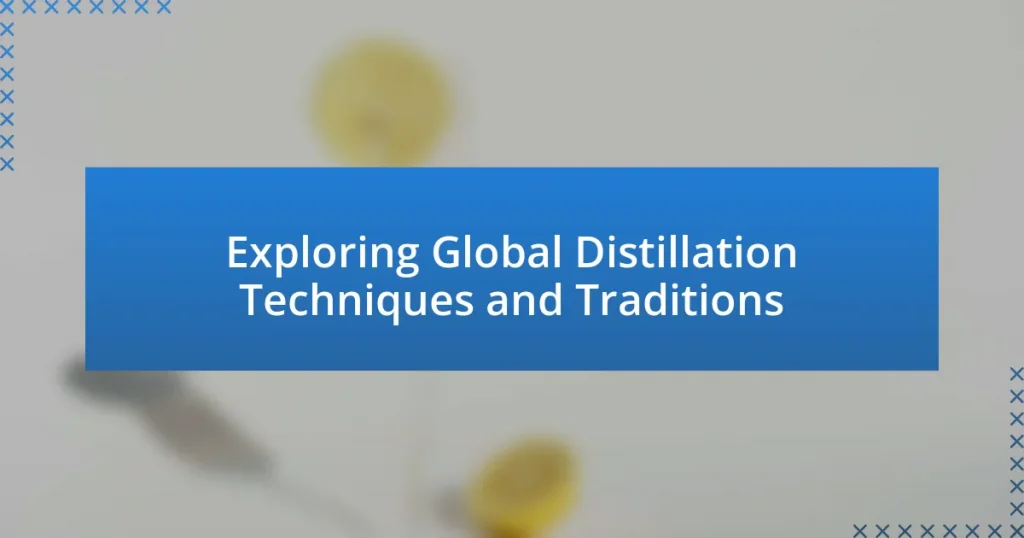Global distillation techniques and traditions encompass the diverse methods and cultural practices used worldwide to separate and purify liquids, particularly in the production of alcoholic beverages and essential oils. The article examines various distillation methods, including pot distillation, column distillation, and vacuum distillation, highlighting their cultural significance and historical influences across different regions. It explores how local ingredients shape distillation practices, the primary purposes of distillation in various cultures, and the impact of modern innovations on traditional methods. Additionally, the article addresses the challenges faced by traditional distillers in a contemporary context and outlines best practices for enhancing distillation efficiency and quality control.

What are Global Distillation Techniques and Traditions?
Global distillation techniques and traditions refer to the various methods and cultural practices used worldwide to separate and purify liquids, primarily in the production of alcoholic beverages, essential oils, and other distilled products. Techniques such as pot distillation, column distillation, and vacuum distillation are employed in different regions, each reflecting local customs and technological advancements. For instance, pot distillation is traditionally used in Scotland for whisky production, while column distillation is prevalent in the production of vodka in Eastern Europe. These methods not only serve practical purposes but also embody the cultural heritage and craftsmanship of the regions where they are practiced, showcasing the diversity of distillation traditions globally.
How do different cultures approach distillation?
Different cultures approach distillation through unique techniques and purposes, reflecting their historical and social contexts. For instance, in Europe, particularly in countries like Scotland and Ireland, distillation is primarily associated with whiskey production, utilizing pot stills to create distinct flavors through multiple distillations. In contrast, Asian cultures, such as in China, employ distillation for producing spirits like baijiu, often using continuous column stills that allow for higher efficiency and varying alcohol content. Additionally, Middle Eastern cultures have a long history of distilling essential oils and perfumes, showcasing a different application of the distillation process. These cultural practices highlight the diversity in distillation methods and their significance in local traditions and economies.
What historical factors influence distillation practices in various regions?
Historical factors such as climate, available resources, cultural practices, and trade routes significantly influence distillation practices in various regions. For instance, in regions with abundant grains, like Scotland, whisky distillation evolved due to the availability of barley, while in warmer climates, such as the Caribbean, sugarcane became the primary source for rum production. Additionally, cultural traditions, such as the use of specific herbs and spices in local spirits, reflect the historical influences of indigenous practices and colonial interactions. Trade routes facilitated the exchange of techniques and ingredients, further shaping regional distillation methods, as seen in the spread of gin from the Netherlands to England in the 17th century.
How do local ingredients affect distillation methods?
Local ingredients significantly influence distillation methods by determining the flavor profile, fermentation process, and overall efficiency of the distillation. For instance, the use of locally sourced grains, fruits, or botanicals can lead to distinct variations in spirits, as seen in the production of whiskey in Scotland, where local barley and water contribute to unique characteristics. Additionally, the availability of specific ingredients can dictate the fermentation techniques employed; for example, sugarcane is essential for rum production in Caribbean regions, leading to different distillation practices compared to those used for grain-based spirits. This relationship between local ingredients and distillation methods is evident in the diversity of global spirits, showcasing how regional resources shape production techniques and flavor outcomes.
What are the primary purposes of distillation across cultures?
The primary purposes of distillation across cultures include the production of alcoholic beverages, purification of water, and extraction of essential oils. In many cultures, distillation is essential for creating spirits such as whiskey, vodka, and rum, which have historical significance and economic value. Additionally, distillation is utilized to purify water, especially in regions lacking access to clean drinking water, ensuring safety and health. Furthermore, the extraction of essential oils through distillation is a common practice in aromatherapy and traditional medicine, highlighting its importance in cultural rituals and wellness practices. These purposes demonstrate the versatility and significance of distillation in various cultural contexts.
How is distillation used in the production of beverages?
Distillation is a process used in the production of beverages to separate and purify liquids based on differences in boiling points. This technique is essential for creating spirits such as whiskey, vodka, and rum, where fermentation produces a mixture of alcohol and water, and distillation concentrates the alcohol by evaporating it and then condensing it back into liquid form. For example, in whiskey production, the fermented mash is heated in a still, allowing alcohol to vaporize and then cool, resulting in a higher alcohol content in the final product. Distillation not only enhances the flavor profile by removing impurities but also increases the alcohol concentration, which is crucial for the beverage’s quality and characteristics.
What role does distillation play in the creation of essential oils?
Distillation is a crucial process in the creation of essential oils, as it separates volatile aromatic compounds from plant materials. This method typically involves steam distillation, where steam passes through the plant material, causing the essential oils to evaporate. The vapor is then cooled and condensed back into liquid form, allowing for the collection of pure essential oils. Historical evidence shows that distillation has been used for centuries, with records dating back to ancient civilizations, highlighting its effectiveness in extracting concentrated plant essences.

What are the Key Types of Distillation Techniques?
The key types of distillation techniques include simple distillation, fractional distillation, steam distillation, and vacuum distillation. Simple distillation is used for separating liquids with significantly different boiling points, while fractional distillation allows for the separation of mixtures with closer boiling points through the use of a fractionating column. Steam distillation is employed for heat-sensitive materials, such as essential oils, where steam is passed through the substance to vaporize the volatile components. Vacuum distillation is utilized to lower the boiling points of substances by reducing the pressure, making it suitable for high-boiling compounds. Each technique serves specific purposes in various industries, including chemical manufacturing and essential oil extraction.
What are the differences between pot still and column still distillation?
Pot still distillation and column still distillation differ primarily in their design and efficiency. Pot stills are traditional, batch-operated distillation units that consist of a large pot where the mash is heated, allowing for a slower distillation process that typically results in a richer flavor profile. In contrast, column stills, also known as continuous stills, utilize a vertical column filled with packing material, enabling a continuous flow of the mash and a more efficient, faster distillation process that produces a higher alcohol content and a cleaner spirit. This distinction is significant as pot stills are often used for producing spirits like whiskey and rum, while column stills are commonly employed in the production of vodka and gin, reflecting their respective applications in the spirits industry.
How does pot still distillation impact flavor profiles?
Pot still distillation significantly enhances flavor profiles by allowing for a more nuanced extraction of volatile compounds. This method, characterized by its simple design and batch processing, retains more of the original ingredients’ flavors and aromas compared to column stills. The pot still’s ability to operate at lower temperatures and its less efficient separation of alcohol from other compounds result in a richer, more complex spirit. For example, traditional Scotch whisky, often distilled in pot stills, showcases a wide range of flavors, from fruity to smoky, due to this method’s selective distillation process.
What advantages does column still distillation offer in production efficiency?
Column still distillation significantly enhances production efficiency by enabling continuous operation and higher throughput. This method allows for the simultaneous distillation of multiple fractions, which increases the yield of desired products while reducing energy consumption. For instance, column stills can achieve higher purity levels in a single pass compared to pot stills, minimizing the need for multiple distillation cycles. Additionally, the design of column stills facilitates better heat integration and recovery, further optimizing energy use and operational costs.
What are some traditional distillation methods still in use today?
Some traditional distillation methods still in use today include pot still distillation, column still distillation, and alembic distillation. Pot still distillation, commonly used in the production of whiskey and rum, involves heating a fermented mash in a pot-shaped vessel, allowing for the separation of alcohol from the mixture. Column still distillation, often utilized for vodka and gin, employs a continuous column that allows for multiple distillation stages, resulting in a higher purity of alcohol. Alembic distillation, a method with origins in the Middle East, is characterized by its unique design and is still used for producing spirits like arak and ouzo. These methods have historical significance and continue to be favored for their ability to impart distinct flavors to the final products.
How is the alembic still utilized in various cultures?
The alembic still is utilized in various cultures primarily for the distillation of alcoholic beverages and essential oils. In regions such as the Middle East, the alembic is traditionally used to produce arak, an anise-flavored spirit, while in Europe, it is employed in the production of whiskey and gin. Additionally, in India, the alembic is integral to the distillation of essential oils from plants for use in traditional medicine and perfumery. Historical records indicate that the alembic has been in use since at least the 8th century, showcasing its enduring significance across different cultures in the art of distillation.
What unique techniques are employed in Asian distillation traditions?
Asian distillation traditions employ unique techniques such as pot still distillation, continuous column distillation, and the use of specific local ingredients. Pot still distillation, prevalent in countries like Japan and China, allows for the production of spirits with distinct flavors by using traditional copper stills that enhance the aromatic qualities of the distillate. Continuous column distillation, utilized in places like India for producing spirits like whisky and rum, enables higher efficiency and purity by allowing for the continuous flow of mash through the distillation process. Additionally, the incorporation of local ingredients, such as rice in sake production or sugarcane in rum, contributes to the unique flavor profiles of the spirits produced in these regions. These techniques reflect the cultural heritage and local resources, making Asian distillation practices distinct in the global context.

How do Modern Innovations Influence Distillation Practices?
Modern innovations significantly enhance distillation practices by introducing advanced technologies such as continuous distillation systems, automated monitoring, and data analytics. These technologies improve efficiency, reduce energy consumption, and enhance product quality. For instance, continuous distillation allows for a more consistent output and minimizes downtime compared to traditional batch methods. Additionally, automated monitoring systems enable real-time adjustments to temperature and pressure, optimizing the distillation process and ensuring higher purity levels. Data analytics further supports distillers by providing insights into production trends and quality control, leading to more informed decision-making and improved operational efficiency.
What technological advancements have transformed distillation?
Technological advancements that have transformed distillation include the development of continuous distillation processes, advanced heat exchangers, and automation technologies. Continuous distillation allows for the uninterrupted separation of components, improving efficiency and reducing energy consumption compared to batch distillation. Advanced heat exchangers enhance thermal efficiency by recovering heat from the distillation process, which minimizes energy costs. Automation technologies, including process control systems and real-time monitoring, optimize operational parameters, ensuring consistent product quality and reducing human error. These advancements collectively contribute to more efficient, cost-effective, and environmentally friendly distillation practices.
How do modern sensors and automation improve distillation accuracy?
Modern sensors and automation enhance distillation accuracy by providing real-time data and precise control over the distillation process. These technologies enable continuous monitoring of variables such as temperature, pressure, and composition, allowing for immediate adjustments to optimize separation efficiency. For instance, advanced sensors can detect minute changes in vapor composition, ensuring that the desired product quality is consistently achieved. Automation systems can also implement algorithms that adjust operational parameters dynamically, reducing human error and variability in the process. This integration of technology leads to improved yield and purity, as evidenced by studies showing that automated distillation systems can achieve up to 10% higher efficiency compared to traditional methods.
What impact do sustainable practices have on contemporary distillation methods?
Sustainable practices significantly enhance contemporary distillation methods by reducing energy consumption and minimizing waste. For instance, the adoption of renewable energy sources, such as solar or wind power, in distillation processes can lower carbon emissions and operational costs. Additionally, techniques like heat recovery systems improve efficiency by reusing energy within the distillation process, which can lead to a reduction in water usage and lower environmental impact. Research indicates that distilleries implementing these sustainable practices can achieve up to a 30% reduction in energy use, demonstrating the tangible benefits of integrating sustainability into distillation.
What are the challenges faced by traditional distillers in a modern context?
Traditional distillers face several challenges in a modern context, including competition from industrial producers, regulatory pressures, and changing consumer preferences. The rise of large-scale distillation operations has led to increased market saturation, making it difficult for traditional distillers to maintain their market share. Additionally, stringent regulations regarding production methods and labeling can impose significant operational burdens. Furthermore, consumers are increasingly favoring craft spirits and innovative flavors, which may not align with traditional distillation practices. These factors collectively threaten the viability of traditional distilling methods and the preservation of cultural heritage associated with them.
How do regulations affect traditional distillation practices?
Regulations significantly impact traditional distillation practices by imposing legal standards that govern production methods, safety protocols, and product labeling. These regulations often require distillers to obtain licenses, adhere to specific quality control measures, and comply with health and safety guidelines, which can alter traditional methods that have been passed down through generations. For instance, in the European Union, the production of spirits is regulated under the EU Spirits Regulation, which mandates that certain traditional practices must be documented and followed to maintain authenticity and protect geographical indications. This regulatory framework can lead to increased costs and operational changes for distillers, potentially threatening the preservation of traditional techniques.
What strategies can traditional distillers adopt to remain competitive?
Traditional distillers can adopt innovative product diversification to remain competitive. By expanding their offerings to include unique flavors, organic options, or limited-edition releases, distillers can attract a broader customer base. For instance, the craft spirits market has seen a significant rise, with sales increasing by 20% annually from 2015 to 2020, indicating consumer interest in artisanal and diverse products. Additionally, leveraging local ingredients can enhance brand authenticity and appeal to consumers’ preferences for sustainability and local sourcing. Implementing modern marketing strategies, such as social media engagement and storytelling about the distillation process, can further strengthen brand loyalty and visibility in a crowded market.
What Best Practices Can Enhance Distillation Techniques?
Best practices that can enhance distillation techniques include optimizing temperature control, ensuring proper equipment maintenance, and utilizing high-quality raw materials. Temperature control is crucial as it affects the separation of components; maintaining a consistent temperature can improve yield and purity. Regular maintenance of distillation equipment, such as cleaning and checking for leaks, ensures efficient operation and prevents contamination. Additionally, using high-quality raw materials leads to better flavor profiles and higher-quality distillates, as impurities in the starting materials can adversely affect the final product. These practices are supported by industry standards and research indicating that attention to these factors significantly improves distillation outcomes.
How can distillers ensure quality control in their processes?
Distillers can ensure quality control in their processes by implementing rigorous testing and monitoring protocols throughout production. This includes regular analysis of raw materials, fermentation, distillation, and aging processes to maintain consistency and quality. For example, distillers often utilize gas chromatography to analyze the chemical composition of their spirits, ensuring that they meet specific flavor and aroma profiles. Additionally, adherence to industry standards and certifications, such as those set by the Alcohol and Tobacco Tax and Trade Bureau (TTB) in the United States, further reinforces quality control measures. These practices collectively help distillers produce high-quality spirits that meet consumer expectations and regulatory requirements.
What tips can improve the efficiency of distillation operations?
To improve the efficiency of distillation operations, optimizing the heat input and maintaining proper temperature control are essential. Efficient heat transfer can be achieved by using high-quality heat exchangers and ensuring that the distillation column is well-insulated to minimize heat loss. Additionally, maintaining a consistent feed composition and flow rate enhances separation efficiency, as fluctuations can lead to reduced product purity and yield. Implementing advanced control systems, such as automated feedback loops, can further optimize operational parameters in real-time, leading to improved performance. Studies have shown that these practices can increase overall distillation efficiency by up to 30%, demonstrating their effectiveness in industrial applications.


